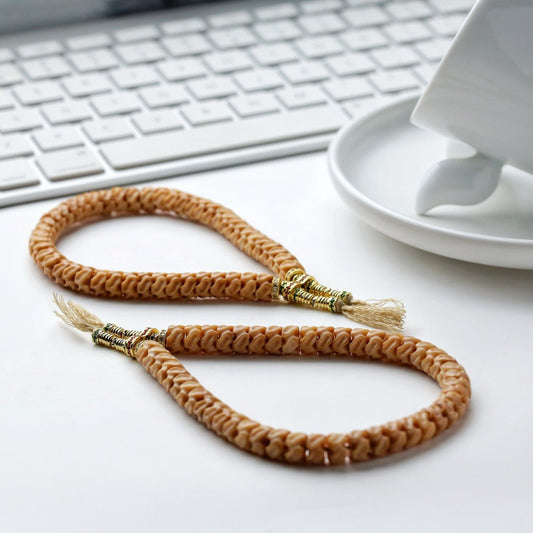
Amid the detailed mesh of Tibetan Buddhism exist a pair of significant objects: the colorful thangka and consecrated bodhi token. All individually, in distinct form, function to connect with higher wisdom. The thangka, a detailed mural, displays revered icons, sacred graphics, or ancient stories, offering meditation guidance.
Meanwhile, the bodhi bead, often crafted from fine gems, grain, pips, or calcium deposits, is a tangible reminder of Buddha's realization under the bodhi tree. Using the beads while meditating strengthens attentiveness.
- Mutually, the thangka and the bodhi bead represent the connection of beauty and piety. They offer a tangible link to the ancient wisdom of Tibetan Buddhism.
Tales Whispered by Camel Bone
Through the passage of eras, antique treasures whisper tales about a world long forgotten. These are not precious objects belonging to lost empires, but simple camel bones carved with figures that enclose the arcana of a bygone period. Each relic contains the echo from a life lived, a journey navigated, and a connection to the venerable wisdom which includes us all.
- Such relics
- Bones
- Act as
Understanding the Iconography of Thangka Creations
Tangkas are striking paintings on canvas, meticulously crafted by Tibetan artists to depict revered figures and scenes from Buddhist literature. Each detail within a thangka is laden with relevance, forming a complex tapestry of visual narratives that guide the viewer on a inner journey. The tints used in thangkas are not merely aesthetic choices but carry meaningful connotations, denoting different aspects of the Buddhist path. From the imposing figures to the intricate decorations, thangkas offer a window into the rich world of Tibetan Buddhism, inviting us to consider upon its understanding.
- Traditional thangka art often depicts key Buddhist figures such as Buddha Shakyamuni, Bodhisattvas like Avalokiteshvara and Manjushri, and enlightened beings from various sects of Tibetan Buddhism.
- Amidst these representations lies a wealth of expertise that can be unlocked by those who examine the symbolic language of thangkas.
Siddhartha's Path to Enlightenment: Embodied in Beads and Bone
Upon the winding way to liberation, the Buddha exercised artifacts imbued with profound resonance. All bead and object held within them the quintessence of his wisdom, demonstrating glimpses into the mosaic of reality. Alongside their profile, the Buddha transmitted profound revelations that outshine the realm of prosaic perception.
From chosen sacred beads, crafted from unique materials, spread vibrations that corresponded with the deepest frequencies within. The fragment of a individual, meticulously transformed into talismans, served as tangible emblems of the impermanence constitutional to all entities.
Thangkas: Windows into Himalayan Spirituality
Thangkas vivid paintings on cloth serve as effective representations of Himalayan spirituality. These intricate works of art, meticulously created with exquisite brushstrokes, depict a vast array consisting of Buddhist deities, mandalas, and scenes from sacred scriptures. Each thangka is a meditative instrument for meditation and contemplation, offering understanding into the subtle teachings of Buddhism.
- They are often used in ritual ceremonies and
- eliciting states of spiritual transcendence.
- Thangkas appear as not merely decorative creations but rather doorways into the rich and captivating world of Himalayan spiritual traditions.
The Spiritual Significance of Bodhi Beads in Mindfulness and Compassion
Each unit on a bodhi bead mala whispers tales of ancient wisdom, guiding us on a pilgrimage through the tranquil waters of mindfulness. As we carry these intricately formed beads, our fingers trace the contours of singular one, anchoring our attention in the present moment. The gentle burden of the beads against our palms serves as a tangible reminder to inhale, fostering a sense of stillness.
- Every time bead that passes between our fingers, we enhance compassion, extending it first to ourselves and then outward to the world.
- Eastern philosophy teaches us that mindfulness is a craft that requires patience and steadfastness.
With the aid of the rhythmic repetition of mantra or simply the mindful tallying of the beads, we release from the relentless chatter of the mind.
The practice incorporating bodhi beads is a refined invitation to re-engage our connection with ourselves and the world around us.
The Power of Intention: Crafting a Camel Bone Bracelet for Spiritual Growth
Aim constitutes an essential momentum in our lives, shaping our experiences and guiding us towards our foreordained route. When we combine this intention with the venerable truths of crafting a camel bone bracelet, we create a potent synergy that can accelerate our spiritual growth.Camel bone embodies meaningful essence, representing stamina. Its natural beauty and ancient magnetism serve as a constant reminder of the core vitality within each of us.While choosing every element, inject meaningful wishes. With every knot or stitch, we implant our hopes, dreams, and aspirations for spiritual evolution. This act of creation becomes a meditative practice, aligning us with our inner wisdom and guiding us on a path of transformation.- Consider the colors and patterns within the camel bone to reflect your intentions.
- Envision the bracelet becoming a conduit for your intentions.
- Wear it as a constant reminder of your commitment to growth and transformation.
Camel Bone’s Spiritual Emblematic Importance in Buddhism
In the rich tapestry embedded in Buddhist tradition, artifacts often hold profound symbolic meaning. Amid these varied objects, camel bone stands out as a unique and engaging element. Throughout history, this material has been adopted in the crafting for various Buddhist tools, each imbued with specific representations.
- Seen as a symbol of resilience and strength due to the camel's ability to overcome in harsh environments, camel bone often symbolizes spiritual fortitude.
- Complementarily, the color and texture regarding camel bone are believed with some to hold auspicious connotations, denoting purity and serenity.
As a result, camel bone has become a valuable part of Buddhist culture, serving as a tangible association to the profound teachings transmitted through this ancient faith.
Thangka Compositions: Acts of Holiness
Within the ethereal realm of Tibetan Buddhism, Thangka paintings emerge as sacred portals to enlightenment. These breathtaking works, meticulously crafted by skilled artists known as thangkapa, depict a myriad in an array of vibrant deities, celestial beings, and mythical creatures. Each brushstroke imbues profound spiritual significance, narrating ancient tales and philosophical concepts.
- Presenting a vast reservoir of Buddhist iconography, Thangkas serve as both devotional objects and instructional tools. Loyal practitioners gaze upon these paintings during rituals and meditations, seeking to acquire spiritual wisdom.
- Beautifully adorned with intricate details and vibrant hues, Thangkas are considered windows into the divine. Every one painting acts as a symbolic representation of the Divine Figure's teachings and the path to liberation.
Employing their intense imagery and symbolism, Thangka paintings offer a glimpse into the rich philosophical traditions of Tibet. They are a testament to the enduring beauty of Tibetan art and its profound ability to empower.
Embracing the Duality: Thangkas and the Cycle of Life and Death
Thangkas, vivid tapestry scrolls of the Himalayas, manifest an intense meditation on mortality’s impermanence. Each intricate depiction depicts deities and beings engaged in the persistent path of life and death, a assemblage of birth, growth, impermanence, and rebirth. The artists skillfully interlace these concepts within the thangka's domain, highlighting the cohesion of all things. Through vivid icons, they invite us to ruminate on our own path. The cycle circulates, a dance of coming and going, stressing the preciousness of each moment. By embracing this duality, thangkas teach us to accept the beauty in both life's joys and sorrows.Lines of Commitment: The Significance of Bracelets in Buddhist Practice
In the intricate tapestry of Buddhist practice, seemingly simple objects often hold profound meaning. Among these are bracelets, which serve as tangible signs of devotion and commitment Tibetan-style prayer beads to the journey of Buddha. Worn on the wrist, a bracelet performs as a constant reminder of one's aspirations and aspirations. It can evoke the impermanence of life, inducing practitioners to remain present in the present moment. Some bracelets may incorporate sacred inscriptions, such as mantras or the names of Buddhas, which are regarded to summon positive energy and preservation. Others may be made from elements with spiritual significance, like sandalwood or lotus seeds, strengthening the bracelet's impact. Ultimately, the significance of a Buddhist bracelet stems far beyond its physical form. It becomes a powerful tool for quietude, a motivation to live in harmony with the teachings of Buddha, and a origin of one's unwavering trust.